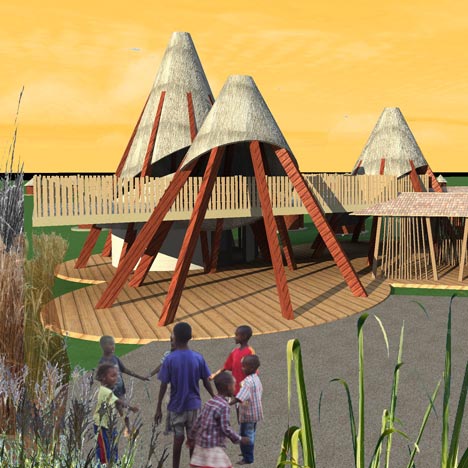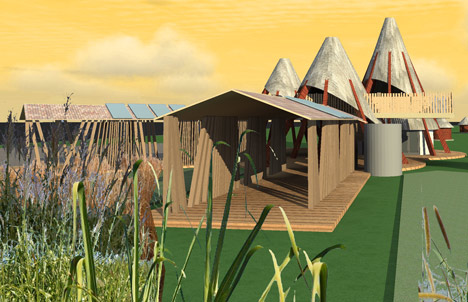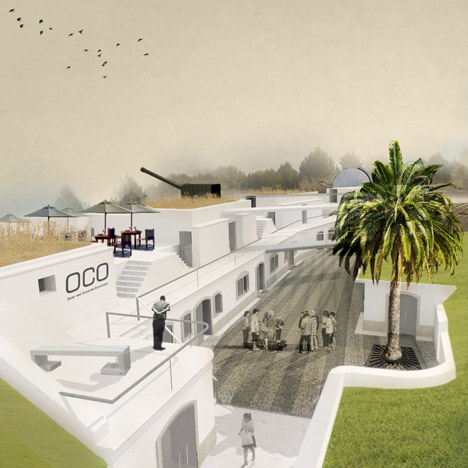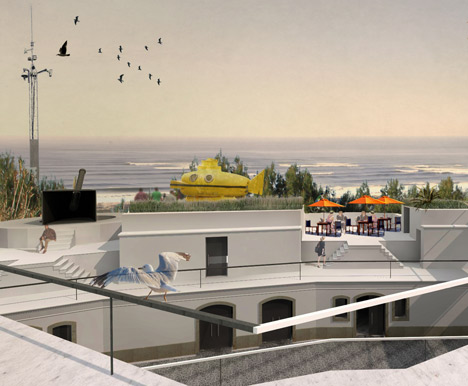
Military zones re-imagined by finalists of Open Architecture Challenge
Dezeen Wire: the winners have been announced for this year's Open Architecture Challenge, hosted by non-profit organisation Architecture for Humanity, with the top award going to a Ugandan proposal to build community hubs in a former refugee camp.

The Founders' Award went to Paicho Huts (above), a proposal to transform a former IDP (internally displaced people's) camp in Gulu, Uganda into community hubs for local people. The Challenge Winner was an Ocean & Coastline Observatory (below) on the site of the Trafaria defence batteries outside Lisbon in Portugal.

Other proposals include a food co-operative for a former air raid shelter in Berlin and a brass foundry to recycle spent ammunition shells in Pretoria, South Africa. See all of the winning projects on the Open Architecture Challenge website.

Over 500 teams submitted work to be judged on five criteria: community impact, contextual appropriateness, ecological footprint, economic viability and design quality.
T. Luke Young, who coordinated the competition at Architecture for Humanity, said the turnout had been "incredible", adding: “This is the most geographically diverse response we’ve had to an Open Architecture Challenge, a fact made more interesting considering the complexity of the project.”
See all our stories about Architecture for Humanity »
Here's the press release from Architecture for Humanity:
August 1, 2012: [UN]RESTRICTED Winners
Winners have been announced for the Open Architecture Challenge: [UN]RESTRICTED ACCESS hosted by Architecture for Humanity. The Founders' Award goes to Paicho Huts, a Ugandan proposal to transform a former IDP camp to benefit rural countrymen. The Winner of the Challenge, OCO - Ocean & Coastline Observatory, is a Portuguese proposal to reassign the Trafaria defense batteries outside Lisbon.
Challenge Winner - Ocean & Coastline Observatory, near Lisbon, Portugal
Founders' Award - Paicho Huts, near Gulu, Uganda
Finalists arranged by jury-determined categories:
Environmental Impact
First Place: Humboldthain Food Cooperative, Berlin, Germany
Second Place: Ecological Processing Zone (EPZ), Oakland, United States
Third Place: REGENERATE FT. CARROLL: a gateway ecological park, Baltimore, United States
Political Response
First Place: ALTER YOUR NATIVE BELFAST//ALTERNATIVE BELFAST, Belfast, United Kingdom
Second Place: Kikotemal' Rik K'aslem Memorial, Guatemala City, Guatemala
Third Place: Healing a Nation: Healing the Wounded, Tripoli, Libya
Economic Development
First Place: Magazine Hill: a weathered continuum, Pretoria, South Africa
Second Place: [ARCH]itecture for Comm[UNITY], Anniston, Alabama, United States
Third Place: The Store - Pillbox Conversion, Napier, New Zealand
Small-scale Intervention
First Place: PLUG-In HEBRON - People Liberated Urban Gaps In Hebron, Old City Hebron, Israeli Occupied Palestinian West Bank
Second Place: B-Tower (TM), various sites, Netherlands
Third Place: Paicho Huts, outside Gulu, Uganda (recipient: Founders' Award)
By the Numbers:
510 teams registered for the challenge
74 countries responsed to the Challenge
174 entries qualified for Round 1 jury
24 semifinalists qualified for Round 2 jury
13 finalists received awards and a feature at the 2012 Venice Biennale
10 countries on 6 continents contain award-winning design proposals
These proposals highlight the results of a Challenge that had engaged 510 teams from 71 countries in re-imagining former military spaces. The nature of the resulting standings reflect the extreme difficulty with which the interdisciplinary jury of 33 professionals evaluated the entries.
From five judging criteria - community impact, contextual appropriateness, ecological footprint, economic viability, and design quality – four further projects showing incredible strength were named equal First Place winners, behind the First Place and Founder’s Award, and seven additional teams identified as Runners-Up. Back-to-back rounds of judging narrowed nearly 200 qualifying proposals to 24 semifinalists, and then the winners.
“The turnout and production for this Challenge were incredible,” remarks T. Luke Young, who coordinated the competition at Architecture for Humanity. “This is the most geographically diverse response we’ve had to an Open Architecture Challenge, a fact made more interesting considering the complexity of the project.” Young recognised the effort made by the jury to provide each entrant with a thorough evaluation.